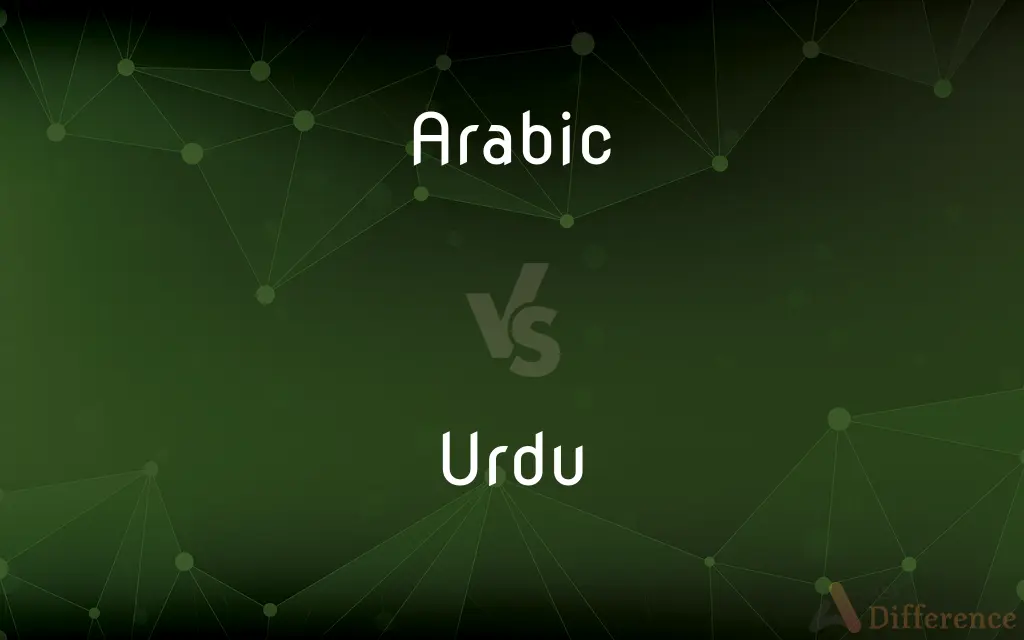Arabic vs. Urdu — What's the Difference?
Edited by Tayyaba Rehman — By Urooj Arif — Updated on March 25, 2024
Arabic is a Semitic language, while Urdu is an Indo-Aryan language, blending Persian, Arabic, and local South Asian languages.

Difference Between Arabic and Urdu
Table of Contents
ADVERTISEMENT
Key Differences
Arabic, a Central Semitic language, is primarily spoken in the Arab world and serves as the liturgical language of Islam. Its script, the Arabic alphabet, is used in a range of languages and has a significant cultural and religious influence. Urdu, on the other hand, is an Indo-Aryan language with a rich literary tradition, primarily spoken in Pakistan and India. It developed under Persian, Arabic, and Turkic influence during the Delhi Sultanate and Mughal Empire, incorporating a significant amount of vocabulary from these languages.
While Arabic maintains a consistent grammar and vocabulary across various regions, Urdu exhibits considerable regional variations and dialects. Arabic's influence on Urdu is most notable in its vocabulary and script, as Urdu is written in a modified form of the Perso-Arabic script, Nastaliq. Despite this shared script, the phonetics, grammar, and basic lexicon of the two languages are distinctly different.
Arabic is characterized by its root-based system, where most words derive from a set of three or four root letters. This system is foundational to Arabic's structure, affecting verbs, nouns, and adjectives. Urdu's structure, while influenced by Arabic, primarily follows the grammatical patterns of Indo-Aryan languages, with a subject-object-verb (SOV) order, and is highly inflected for gender, number, and tense.
The cultural contexts of Arabic and Urdu also differ significantly. Arabic is deeply intertwined with Islamic texts and teachings, serving as a unifying factor across diverse Arab cultures. Urdu, celebrated for its poetic tradition, particularly the Ghazal, has played a crucial role in South Asian culture and history, embodying a blend of indigenous and foreign influences.
Arabic and Urdu also differ in their phonology. Arabic has sounds that are not present in Urdu, such as the emphatic consonants, and its vowels are not as prominently varied. Urdu's phonetic system, influenced by its Indo-Aryan roots and Persian, includes sounds that are not found in Arabic, making pronunciation a notable point of distinction between the two.
ADVERTISEMENT
Comparison Chart
Language Family
Semitic
Indo-Aryan
Script
Arabic alphabet
Modified Perso-Arabic (Nastaliq)
Grammatical Order
Varies, but often VSO (Verb-Subject-Object)
SOV (Subject-Object-Verb)
Cultural Influence
Strongly tied to Islam and Arab culture
Rich poetic tradition, blend of South Asian, Persian, Arabic, and Turkic influences
Phonology
Includes unique emphatic consonants and fewer vowel sounds
Diverse vowel sounds and some phonetics not found in Arabic
Compare with Definitions
Arabic
A Semitic language with a rich historical and religious heritage.
The Quran is written in classical Arabic.
Urdu
An Indo-Aryan language known for its poetic expressiveness.
Urdu poetry, or Shayari, is celebrated for its emotional depth.
Arabic
Uses a root-based system for word formation.
In Arabic, the root k-t-b relates to writing.
Urdu
Developed under Persian and Arabic influence in South Asia.
Urdu borrows extensively from Persian and Arabic vocabulary.
Arabic
Characterized by its own alphabet, used by many languages.
Arabic script is used from Morocco to Iraq.
Urdu
Enriches South Asian cultural and historical narratives.
Urdu literature provides insights into the region's complex history.
Arabic
Has several regional dialects and Modern Standard Arabic.
Egyptian Arabic is one of the most widely understood dialects.
Urdu
Written in a modified Perso-Arabic script, Nastaliq.
Urdu calligraphy is a distinct form of artistic expression.
Arabic
Central to Islamic rituals and teachings.
Daily prayers in Islam are recited in Arabic.
Urdu
Has a variety of dialects across Pakistan and India.
Hyderabadi Urdu is known for its unique phrases and words.
Arabic
Arabic (اَلْعَرَبِيَّةُ, al-ʿarabiyyah [al ʕaraˈbijːa] (listen) or عَرَبِيّ, ʿarabīy [ˈʕarabiː] (listen) or [ʕaraˈbij]) is a Semitic language that first emerged in the 1st to 4th centuries CE. It is now the lingua franca of the Arab world. It is named after the Arabs, a term initially used to describe peoples living in the Arabian Peninsula bounded by eastern Egypt in the west, Mesopotamia in the east, and the Anti-Lebanon mountains and Northern Syria in the north, as perceived by ancient Greek geographers.
Urdu
Urdu (; Urdu: اُردُو, ALA-LC: Urdū) is an Indo-Aryan language spoken chiefly in South Asia. It is the official national language and lingua franca of Pakistan.
Arabic
A Semitic language originating in the Arabian Peninsula that since the 7th century AD has come to be the principal language of a wide area of the Middle East and North Africa. Modern spoken Arabic consists of many different, often mutually unintelligible dialects, and a modified form of classical Arabic is used as the language of education and administration across the area.
Urdu
An Indic language that is the official literary language of Pakistan, essentially identical to Hindi in its spoken form but in its literary form heavily influenced by Persian and Arabic and written in an Arabic alphabet.
Arabic
Of or relating to Arabia, the Arabs, their language, or their culture.
Urdu
The language more generally called Hindustanee.
Arabic
(rare) gum arabic
Urdu
The official literary language of Pakistan, closely related to Hindi; widely used in India (mostly by Moslems); written in Arabic script
Arabic
Of or pertaining to Arabia or the Arabians.
Urdu
Relating to the Urdu language;
Urdu poetry
Arabic
The language of the Arabians.
Arabic
The Semitic language of the Arabs; spoken in a variety of dialects
Arabic
Relating to or characteristic of Arabs;
Arabic languages
Common Curiosities
Why do Arabic and Urdu use similar scripts?
Urdu adopted the Perso-Arabic script through its historical and cultural interactions with Persian and Islamic civilizations, which used the Arabic script.
Can Arabic speakers understand Urdu?
Arabic speakers might recognize some vocabulary in Urdu due to the shared words, but the two languages are distinct and generally not mutually intelligible.
How did Urdu develop its distinctive identity?
Urdu developed its distinctive identity through a synthesis of the local South Asian languages, Persian, Arabic, and Turkic influences, particularly during the Delhi Sultanate and Mughal Empire periods.
Are Arabic and Urdu related to each other?
While they have influenced each other, particularly in vocabulary and script, they belong to different language families and have distinct grammatical structures and phonologies.
Can Urdu be written in scripts other than Nastaliq?
Yes, Urdu can also be written in Devanagari or Roman scripts, especially on social media and in informal contexts, though Nastaliq remains the standard script for formal and literary uses.
How are Arabic and Urdu preserved and promoted?
Both languages are preserved and promoted through educational institutions, literary and cultural organizations, and religious practices, reflecting their importance in respective cultures.
Is Urdu derived from Arabic?
Urdu is not derived from Arabic; it is an Indo-Aryan language that has borrowed extensively from Persian and Arabic, among other languages.
Is it easier for Urdu speakers to learn Arabic, or vice versa?
Knowledge of Urdu can provide a foundational understanding of some Arabic vocabulary, and vice versa, but the grammatical structures, phonology, and script nuances pose challenges for learners transitioning between the two.
Are there any similarities between Arabic and Urdu poetry?
Both Arabic and Urdu poetry share a deep appreciation for intricate wordplay, emotional depth, and themes such as love, philosophy, and social issues, though they employ different poetic forms and styles.
What challenges do learners face when transitioning from Urdu to Arabic or vice versa?
Learners may struggle with differences in grammar, pronunciation, and script, despite some shared vocabulary. Arabic's root system and phonetic nuances, and Urdu's complex verb conjugations and noun cases, can be particularly challenging.
What role does Arabic play in Islamic countries where it's not the native language?
In non-Arab Islamic countries, Arabic holds religious significance, especially in the context of Quranic study and Islamic rituals.
How is Modern Standard Arabic (MSA) different from Classical Arabic?
MSA is a modernized version of Classical Arabic, used in contemporary media, education, and formal settings. It simplifies some grammatical structures but retains a strong connection to Classical Arabic, especially in vocabulary and syntax.
Is it common for Urdu speakers to learn Arabic?
Yes, many Urdu speakers learn Arabic, particularly for religious education, as it enables a deeper understanding of Islamic texts and rituals.
What role does Urdu play in Pakistan's identity?
Urdu serves as Pakistan's national language and lingua franca, uniting diverse ethnic groups and representing the country's cultural and historical heritage.
How does the Arabic influence on Urdu manifest in everyday language?
The Arabic influence is evident in Urdu's vocabulary, especially in words related to religion, science, literature, and administration, reflecting the historical and cultural connections between the regions.
What are the major dialects of Arabic?
Major Arabic dialects include Egyptian, Levantine, Gulf, Maghrebi, and Mesopotamian, each with unique characteristics and regional influences.
How has Urdu influenced Bollywood?
Urdu has significantly influenced Bollywood, especially in its dialogues, song lyrics, and movie titles, enriching the industry with its poetic and emotive expressions.
Share Your Discovery

Previous Comparison
Cold vs. Frigid
Next Comparison
Fall vs. TumbleAuthor Spotlight
Written by
Urooj ArifUrooj is a skilled content writer at Ask Difference, known for her exceptional ability to simplify complex topics into engaging and informative content. With a passion for research and a flair for clear, concise writing, she consistently delivers articles that resonate with our diverse audience.
Edited by
Tayyaba RehmanTayyaba Rehman is a distinguished writer, currently serving as a primary contributor to askdifference.com. As a researcher in semantics and etymology, Tayyaba's passion for the complexity of languages and their distinctions has found a perfect home on the platform. Tayyaba delves into the intricacies of language, distinguishing between commonly confused words and phrases, thereby providing clarity for readers worldwide.














































